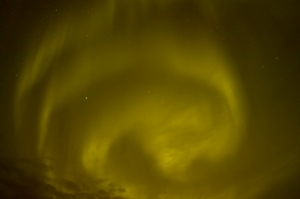

This tip is courtesy of a professional photographer friend of mine, LeRoy Zimmerman, of Fairbanks, Alaska, who specializes in shooting 35mm film panoramas and who does wonderful work with the Northern Lights. The Northern Lights, or aurora borealis, is a phenomenon linked with the sun's activity and solar flares, where electromagnetic radiation reacts with the atmosphere at both the northern and southern end of our planet, creating the dancing, colorful light shows that make magic in an arctic night. I seen them a few times, but either because of our schedule, our shooting conditions, or their briefness, I hadn't been able to photograph them. That changed, recently, on our visit to Churchill, Manitoba to photograph polar bears where the weather was absolutely, completely, unnaturally mild, which allowed us to be out for as long as we needed, at night, without feeling any cold. It was a wonderful opportunity to shoot the Lights, but, unfortunately, this celestrial show only appeared on one of our many clear nights.
One past difficulty in photographing the Northern Lights was the ISO required -- 400 or so, which I rarely carried when I shot film. Now, with digital, this wasn't an issue and for the northern lights Mary and I cranked our ISO up to 400, 800, and even 1000, for exposures ranging from 8 to about 13 seconds. For the first part of this shoot I had to mount my camera upon a beanbag -- we didn't unpack our camera plates yet, since this was the first night of the trip! Luckily, though, Mary drove back to town -- we had driven a short distance out of town to avoid distracting town lights -- and retrieved our plates, so some of our first shots had blurred stars because of camera movement.
However, the trouble with shooting any lengthy time exposures involving the sky is that the stars will streak during the exposure, as the earth rotates, creating the impression that the stars are moving across the sky. The longer the lens focal length, the more that movement will be evident. LeRoy's suggestion is to divide your focal length into 800 (or, to really be safe, 500), and the resulting number is the length of time the shutter can be open before a star trail is evident. Thus, if you were shooting something with a 400mm lens, you'd have only 2 seconds before streaking would occur. Who'd shoot with that long a lens? Well, one of the folks on the polar bear trip was using a Fuji pano with a 300mm lens, so his exposures were limited to 3 seconds or so. For Mary and I, who were using 17-35 or 28-300mm lenses, all at the short end, shutter speeds of 10 seconds or so were not a problem.
| DIGITAL | EQUIPMENT | ADVICE | TRAVEL | WILDLIFE | FIELD TIPS |